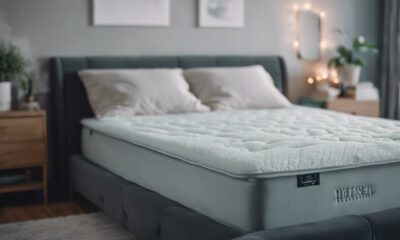Comforter
How Do Comforters Work
A delve into how comforters work reveals the magical science behind keeping you warm and cozy – discover more for a restful night's sleep.
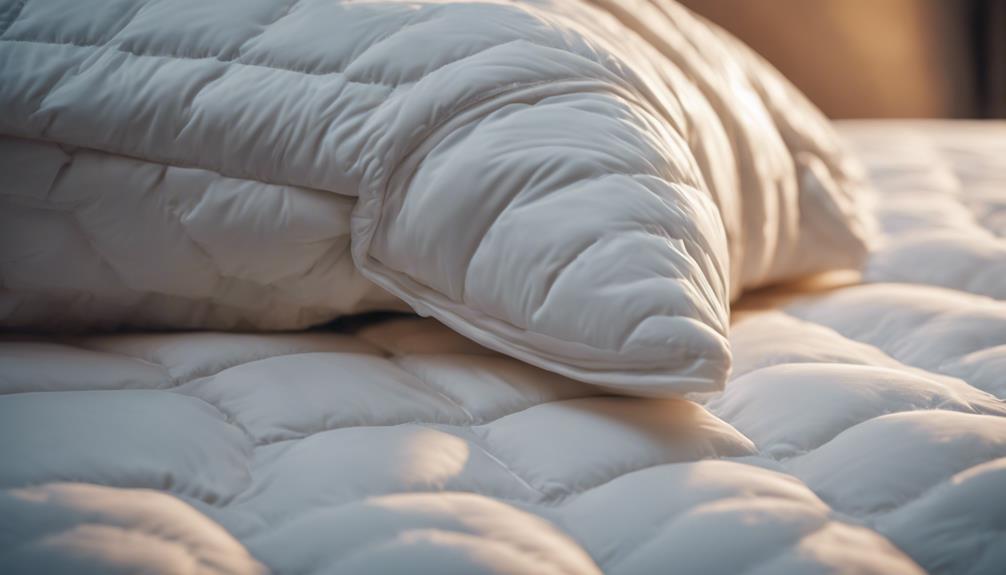
Comforters are designed to efficiently trap body heat using insulating materials such as down, wool, or synthetic fibers. These materials capture warmth and help maintain a regulated temperature for a comfortable night’s sleep. The outer shell fabric ensures even heat distribution and protects the filling. The type of filling used in a comforter affects its heat retention and insulation levels. Customizable thickness options are available to cater to individual warmth preferences. By considering personal needs for warmth, material, and design, choosing the right comforter can be enhanced. For more information on the functionality and benefits of comforters, those interested in learning more about their bedding essentials can explore further details.
Key Takeaways
- Comforters trap body heat with insulating materials.
- Insulation layer distributes and retains warmth evenly.
- Outer shell protects filling and aids in temperature regulation.
- Design elements like stitching and patterns enhance durability.
- Different fill materials impact comforter's heat retention and insulation.
Insulating Materials in Comforters

When selecting insulating materials for comforters, we prioritize their ability to trap heat efficiently while considering factors like weight and breathability.
Down comforters are renowned for their exceptional warmth-to-weight ratio, making them a preferred choice in colder climates. The lofty clusters of down create pockets of air that insulate effectively, providing a cozy sleep experience without feeling heavy on the body.
Wool comforters, on the other hand, offer natural breathability and moisture-wicking properties, helping regulate body temperature for a comfortable rest throughout the night. Their ability to adjust to the body's temperature fluctuations makes them versatile for various seasons.
Synthetic fiber-filled comforters are a practical option for those with allergies, as they're hypoallergenic and often more budget-friendly than natural materials. The choice of insulating material in a comforter significantly impacts its weight, breathability, and overall warmth, catering to individual preferences and needs for a restful night's sleep.
Function of Comforter Outer Shell
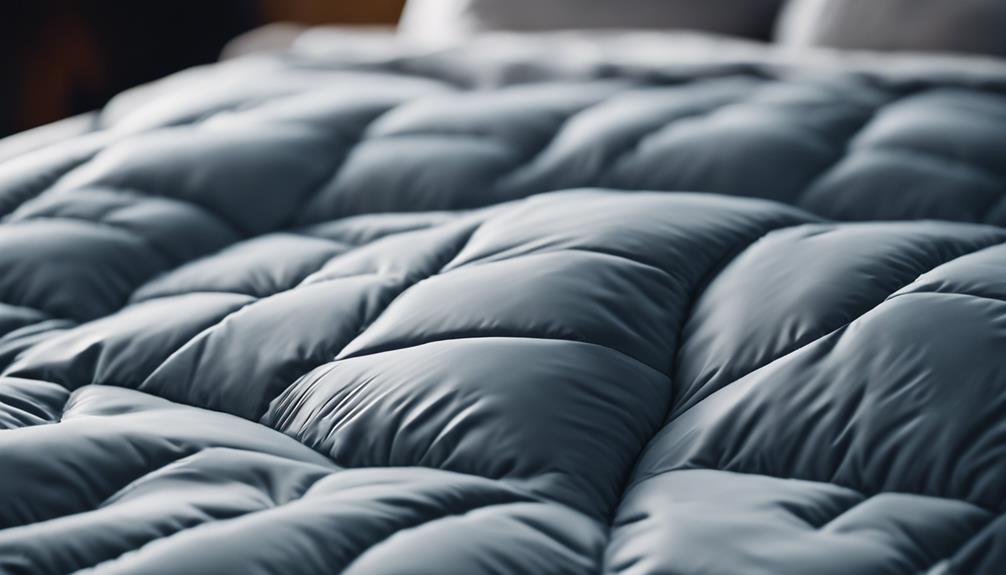
The outer shell of a comforter serves as a vital barrier for the inner filling, ensuring it remains in place for consistent warmth distribution.
It also plays an essential role in determining the comforter's durability and feel, with various materials like cotton, silk, wool, and eucalyptus offering different attributes.
Additionally, the design of the shell contributes to the overall aesthetic of the comforter and can impact the breathability and temperature regulation for a comfortable sleeping experience.
Insulation Layer Purpose
Nestled within the outer shell of a comforter lies the essential insulation layer, diligently capturing and retaining heat to guarantee a cozy night's rest.
This insulation layer is indispensable for warmth distribution, ensuring that you stay comfortably warm throughout the night. By trapping heat efficiently, the outer shell helps regulate the temperature, creating a snug environment for sleep.
Additionally, the outer shell plays an important role in the longevity of the comforter by protecting the filling material. With materials like cotton or silk known for their breathability, the outer shell not only insulates but also provides a comfortable sleeping experience.
Hence, the insulation layer within the outer shell is critical for maintaining a cozy and restful night's sleep.
Fabric Durability Importance
Ensuring the durability of a comforter, the quality of its outer shell fabric is essential for withstanding regular use and maintaining longevity.
The fabric of a comforter's outer shell plays an important role in its overall durability. Materials like cotton, silk, and eucalyptus are known for their excellent durability, ensuring the comforter can withstand frequent use and washing.
Proper care and maintenance of the outer shell fabric are key factors in extending the comforter's lifespan. Fabric durability is important for preventing tears, snags, and general wear over time, making it an essential consideration when selecting a comforter.
Choosing a high-quality fabric for the outer shell can have a significant impact on the comforter's longevity and overall performance.
Design Aesthetic Considerations
To enhance the durability and functionality of a comforter, considering design aesthetic considerations for the outer shell plays a significant role in both the visual appeal and performance of the bedding. The outer shell's design aesthetics, such as patterns and stitching, not only contribute to the overall look of the comforter but also serve a functional purpose. By incorporating visually appealing patterns and reinforced stitching, the outer shell prevents the fill from clumping, ensuring an even distribution throughout the comforter. Additionally, the fabric texture of the outer shell influences the feel and appearance of the comforter. This combination of design elements not only adds warmth and style to the bedding but also enhances its durability, making it a practical and visually pleasing choice.
| Design Aesthetic Considerations | Function |
|---|---|
| Patterns | Prevents fill clumping |
| Stitching | Reinforces durability |
| Fabric Texture | Influences feel and appearance |
Standalone Bedding Piece
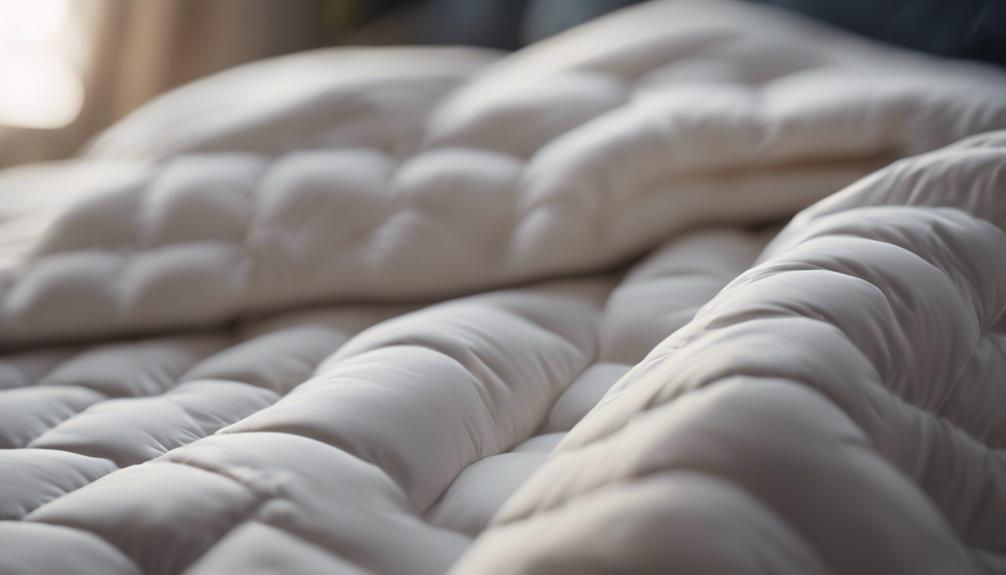
Comforters provide a guarantee of warmth and comfort on their own as a single bedding piece, consisting of two fabric layers stitched together with a soft filling in between. They offer a cozy layer on the bed and are fluffier and heavier than duvets and blankets, making them perfect for colder nights.
The construction of comforters typically includes at least three layers to guarantee warmth and comfort. Various sizes and fillings such as cotton, wool, polyester, down, or silk cater to different preferences and needs. These fillings contribute to the insulation properties of the comforter, trapping heat and maintaining a comfortable temperature throughout the night.
Whether you prefer a lightweight option for warmer seasons or a thicker one for winter, comforters serve as versatile standalone bedding pieces that can be customized to meet your specific requirements for a good night's sleep.
Customization of Comforter Thickness

Selecting the appropriate fill power for a comforter allows for customizable thickness options tailored to individual preferences and climate requirements. Fill power is vital in determining the thickness and insulation of a comforter. Higher fill power ratings result in thicker and warmer comforters, while lower fill power ratings lead to thinner and lighter options.
The range of fill power typically starts at 300 for lightweight comforters and can exceed 800 for ultra-warm choices. The thickness of a comforter plays a significant role in its warmth and weight, as thicker comforters offer more insulation but may feel heavier.
Role of Comforter in Providing Warmth

Comforters play an essential role in keeping us warm at night by trapping body heat within their layers.
The insulating material type and strategic layering of a comforter are key factors in retaining heat and providing comfort.
Understanding how these elements work together can help optimize the warmth and coziness a comforter offers during sleep.
Insulating Material Type
Using a variety of materials such as down, feathers, wool, or synthetic fibers, comforters effectively trap heat to provide warmth for a restful night's sleep. The insulating material within a comforter, like down, feathers, or synthetic fibers, plays an essential role in retaining body heat.
Down, known for its exceptional insulating properties, creates pockets that trap warm air, keeping you cozy throughout the night. Feathers and synthetic fibers also provide insulation, though to varying degrees. Additionally, comforters with quilted stitching help distribute the filling evenly, preventing clumping and ensuring consistent warmth.
The outer fabric of the comforter acts as a protective layer, further enhancing insulation by reducing heat loss. Selecting a comforter with the right insulating material is key to a comfortable and warm sleep environment.
Layering for Heat
Layered within a comforter, the combination of outer shell and inner fill forms a barrier that effectively traps body heat, ensuring warmth throughout the night.
When it comes to layering for heat in comforters, there are a few key points to keep in mind:
- Insulation Properties: The layers of a comforter play an essential role in providing insulation to regulate body temperature and keep sleepers warm.
- Material Impact: Different fill materials like down, synthetic fibers, or wool impact the comforter's ability to retain heat and provide warmth.
- Heat Retention: The design of a comforter is specifically engineered to prevent heat loss, helping to maintain a comfortable sleeping temperature and ensuring a cozy night's rest.
Elimination of Additional Bedding Layers

Simplifying the bedtime routine, comforters replace the need for additional bedding layers through their innovative design. By incorporating multiple layers of fabric and insulation, comforters effectively provide warmth and create a cozy environment for a restful night's sleep.
The unique construction of comforters allows them to trap heat efficiently, eliminating the necessity for extra covers like blankets or quilts. Unlike traditional bedding options, comforters are typically thicker and fluffier, offering sufficient insulation on their own. This feature not only streamlines the bed-making process but also adds a stylish and functional focal point to the bedroom.
As standalone bedding pieces, comforters stand out for their ability to provide both comfort and practicality, making them a versatile choice for creating a snug and inviting sleeping space. With their ability to offer warmth and coziness without the need for additional layers, comforters are a convenient and effective bedding solution.
Variation in Comforter Insulation Levels
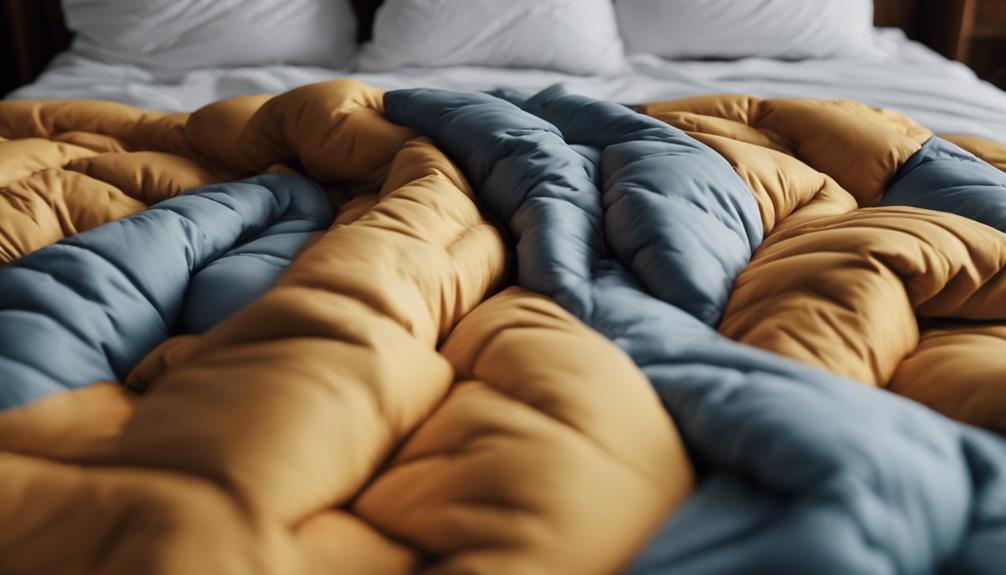
When considering comforters, it's important to understand the variation in insulation levels. Different comforters offer a range of warmth options, from lightweight to extra-warm.
Factors such as the type and amount of filling used determine the insulation level, impacting the comforter's suitability for different seasons.
Insulation Material Types
When contemplating comforter insulation materials, understanding the benefits each material offers is crucial. Here are three common types:
- Down and Feathers: Renowned for their exceptional warmth and insulation properties due to the natural loft and air-trapping abilities of down clusters.
- Synthetic Fill: Perfect for individuals with allergies to down or feathers, as synthetic fill comforters are hypoallergenic and provide reliable insulation.
- Wool: Provides natural insulation, moisture-wicking capabilities, and temperature regulation, ensuring a comfortable night's sleep.
Considering these options can assist you in choosing a comforter that aligns with your preferences and needs.
Warmth Level Options
Exploring the warmth level options in comforters reveals a range of insulation levels tailored to different climate conditions and personal preferences. Comforters offer varying degrees of warmth through different insulation levels, determined by the fill material and fill power. Materials like down, feathers, wool, cotton, or synthetic fibers provide different levels of insulation.
The thickness and density of the fill play a significant role in a comforter's ability to retain heat. Higher fill power, often found in down or feather-filled comforters, offers superior warmth due to increased loft and air-trapping capabilities. When choosing a comforter, consider your local climate and personal comfort preferences to secure a restful night's sleep.
Understanding these warmth level options helps in selecting the most suitable comforter for your needs.
Seasonal Suitability Differences
As we consider the seasonal suitability differences in comforters, it becomes evident that the variation in insulation levels plays an important role in providing ideal warmth throughout the year.
The insulation level of a comforter, determined by its fill material and thickness, dictates how effectively it traps body heat, ensuring a cozy sleep experience.
Lighter comforters are perfect for warmer seasons due to their lower insulation levels, while heavier ones with increased insulation are more suitable for colder seasons to provide enhanced warmth.
Understanding the seasonal suitability of comforters is essential in selecting the right one to maintain comfort and regulate body temperature year-round.
Comforter Personalization Based on Preferences

By understanding individual preferences such as warmth level, material, and design, comforters can be personalized to cater to specific needs and tastes.
When it comes to comforter personalization, there are various options available to make sure that your bedding meets your requirements. Preferences for comforter thickness, fill type (whether down, synthetic, or wool), and size can all be tailored to suit different needs.
Some comforters even offer adjustable warmth levels through features like removable layers or different fill densities, allowing you to customize the coziness level based on your preferences.
Personalization options extend to selecting hypoallergenic materials, eco-friendly choices, and specific thread counts for added comfort and peace of mind.
Additionally, customization features such as reversible designs, pattern choices, and a variety of color options enable you to add a unique and personalized touch to your bedding, ensuring that your comforter reflects your individual style and preferences.
Benefits of Comforter Size Customization

Customizing the size of a comforter guarantees a perfect fit for various bed sizes, such as twin, queen, or king. When it comes to bedding, having the right comforter size can make a significant difference. Here are some benefits of custom-sized comforters:
- Enhanced Aesthetic Appeal: Tailored comforter sizes prevent excess fabric or shortages, ensuring a neat and polished appearance for your bed.
- Personalized Comfort: By choosing the right comforter size, you can enjoy ideal coverage and comfort tailored to your individual preferences, promoting a restful night's sleep.
- Seamless Coordination: Custom-sized comforters allow for a seamless look when paired with matching duvet covers or bed linens, creating a cohesive and well-coordinated bedding ensemble.
Choosing the appropriate comforter size not only adds to the overall aesthetics of your bedroom but also guarantees practical benefits such as preventing shifting or bunching, maintaining a tidy and cozy bed look.
Seasonal Adaptability With Comforters
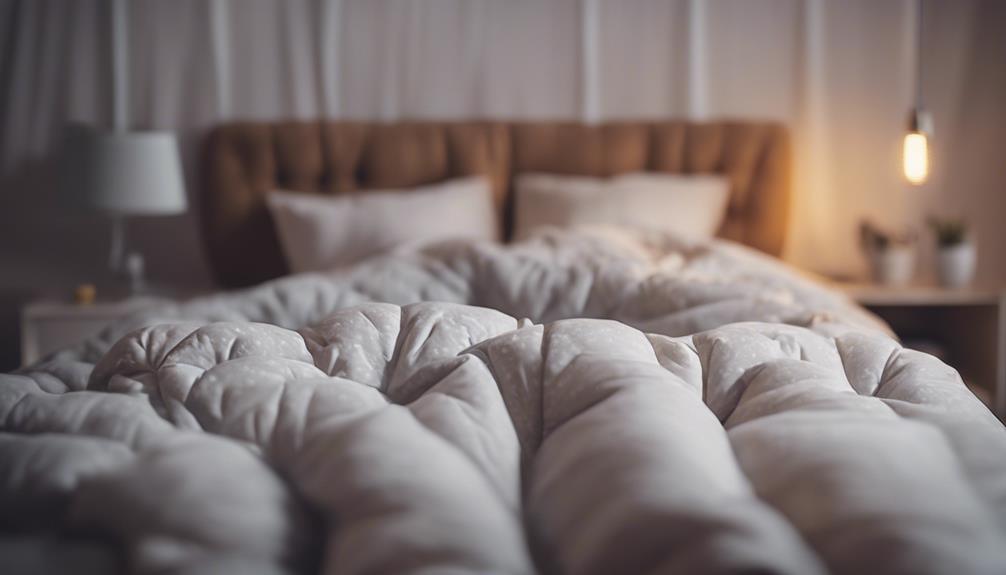
Comforters adapt to seasonal changes by providing warmth in colder months and breathability in warmer seasons, ensuring comfort year-round. The seasonal adaptability of comforters is achieved through the selection of suitable fillings like down, synthetic fibers, or wool, depending on local weather conditions.
Lightweight comforters are perfect for summer, allowing airflow and preventing overheating, while heavier comforters offer insulation and coziness during winter months. This versatility allows comforters to be layered with sheets for extra warmth or used alone as the weather shifts.
Frequently Asked Questions
Do You Sleep on Top or Under a Comforter?
We typically sleep under a comforter. Placing it on top of the sheets provides an additional layer of warmth and insulation, keeping us cozy during sleep.
This setup helps regulate body temperature and guarantees a comfortable sleeping experience. The soft filling inside the comforter adds to its insulating properties, creating a snug and inviting bed environment.
Do You Need a Blanket With a Comforter?
We don't necessarily need a blanket with a comforter. Comforters are designed to provide warmth and insulation on their own, without the need for an extra layer. Some people prefer using a comforter alone to simplify bedding and reduce bulk on the bed.
However, the choice to use a blanket with a comforter ultimately depends on personal preference for added warmth and comfort. It's a matter of individual needs and comfort levels.
Do You Put Something Over a Comforter?
Yes, it's common to put something over a comforter for added warmth or style. Duvet covers and top sheets are popular choices. Duvet covers protect the comforter and are easy to wash, making them durable.
Top sheets offer a way to change up the bedding look easily. Adding layers like quilts or throws can provide extra coziness and visual interest.
Coverlets or bedspreads can add texture and flair to your bedding ensemble.
How Do Cooling Comforters Work?
Cooling comforters work by using breathable fabrics and cooling gel or fibers to regulate body temperature during sleep. They promote air circulation and prevent heat buildup, making them ideal for hot sleepers.
These comforters are lightweight and designed to provide a cooler sleep experience in warmer climates. One interesting statistic is that cooling comforters can lower body temperature by a few degrees, enhancing comfort and improving sleep quality.
Do Hilton’s Comforters Work the Same Way as Regular Comforters?
Yes, Hilton comforter details reveal that they work similarly to regular comforters. They are designed to provide the same level of warmth, comfort, and style. The key difference lies in the quality of materials and construction, ensuring a luxurious experience for guests at Hilton properties.
Conclusion
To sum up, comforters work by using insulating materials to trap heat and provide warmth while sleeping.
Did you know that the average person spends about one-third of their life in bed? That's a lot of time to enjoy the comfort and coziness that a good comforter can provide.
So, choose a comforter that suits your preferences and needs, and enjoy a restful night's sleep all year round.
Comforter
Can I Use a Down Comforter as a Mattress Topper
Optimize your sleep comfort with a down comforter as a mattress topper, offering luxurious softness and enhanced insulation – find out more!
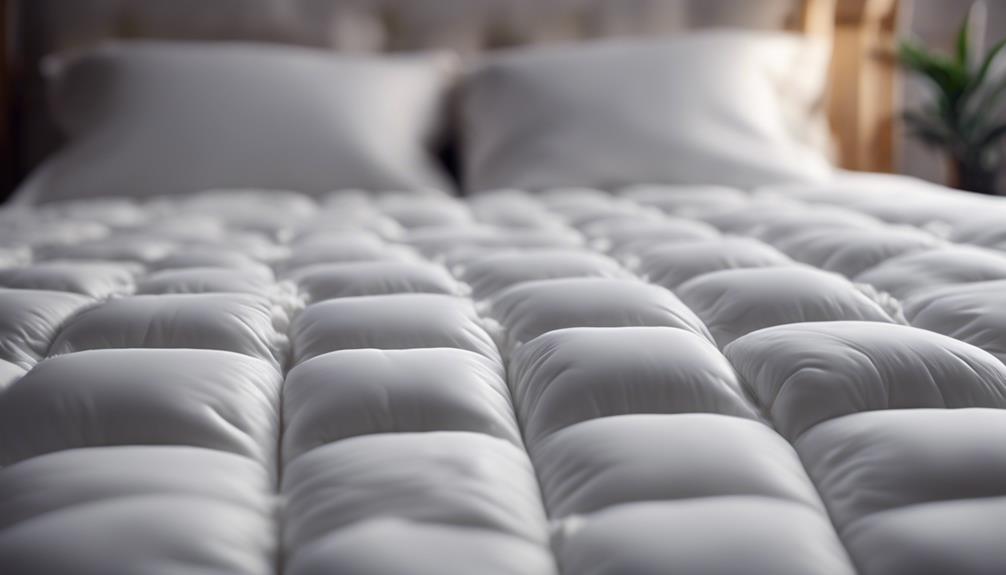
Using a down comforter as a mattress topper can improve the comfort and insulation of your bed. Placing it directly on top of the mattress underneath the fitted sheet allows it to conform to your body shape and provide a comfortable surface to sleep on. Before using, consider the thickness, fill power, and baffle box construction for the desired level of support. Regular cleaning and maintenance can help keep the down comforter feeling plush. Adding a down comforter to your bedding can add luxury and softness to your sleep, using white duck down for insulation. Its lightweight quality makes it easy to handle on the mattress. Learn more about the advantages and proper care to enhance your sleep experience.
Key Takeaways
- Down comforters can be used as mattress toppers for added comfort and warmth.
- Ensure the comforter fits the mattress size to provide effective coverage.
- Regularly rotate and fluff the comforter to maintain its plush feel.
- Consider using a cotton cover or duvet for extra protection.
- Enjoy the luxury and coziness of a down comforter as a versatile mattress topper.
Benefits of Using a Down Comforter
Using a down comforter as a mattress topper can greatly enhance the overall comfort and warmth of your bed. The feather-filled topper adds an extra layer of softness and coziness to your mattress, making for a more comfortable sleep experience.
The down filling, whether from geese or ducks, creates a plush feel that can help maintain body temperature while providing insulation during the night. This means you can stay warm and snug without feeling overheated.
By placing a down comforter on top of your mattress, you transform your bed into a haven of relaxation, perfect for unwinding after a long day. The topper's versatility allows for easy placement and removal, making it a convenient choice for those seeking a quick way to upgrade their sleep environment.
How to Properly Place a Down Comforter

To properly position a down comforter on your mattress for the best comfort and support, start by making sure it lies directly on top of the mattress under the fitted sheet. This positioning allows the down comforter, filled with luxurious white goose down, to adjust to your body contours, providing a cozy and supportive sleep surface. High-quality materials, such as Hungarian white goose down, offer extraordinary comfort, making your bed a sumptuous sanctuary for a restful night's sleep.
Proper placement of the down comforter is essential for maximizing its benefits. Regularly rotating the comforter and snapping it like a flat sheet can help redistribute the down evenly, maintaining its loft over time. By following these simple steps, you can guarantee that your down comforter remains plush and supportive, offering you a luxurious sleeping experience every night.
Factors to Consider Before Using

When contemplating using a down comforter as a mattress topper, evaluating its thickness and weight is vital to guarantee it offers the desired cushioning and support. The fill power of the comforter affects its fluffiness and insulating ability, so choose a fill power that suits your needs. Check if the comforter has baffle box construction to keep the down evenly distributed and prevent it from shifting. A cotton cover can help protect your mattress and provide a soft surface for sleeping. Make sure the comforter is the right size for your mattress to cover it effectively and stay securely in place.
Using a down comforter as a mattress topper can add extra warmth, which is beneficial in colder climates. However, it's important to take these factors into account before making the switch to ensure excellent comfort and functionality. By evaluating these elements, you can make an informed decision about using a down comforter as a mattress topper.
Cleaning and Maintenance Tips
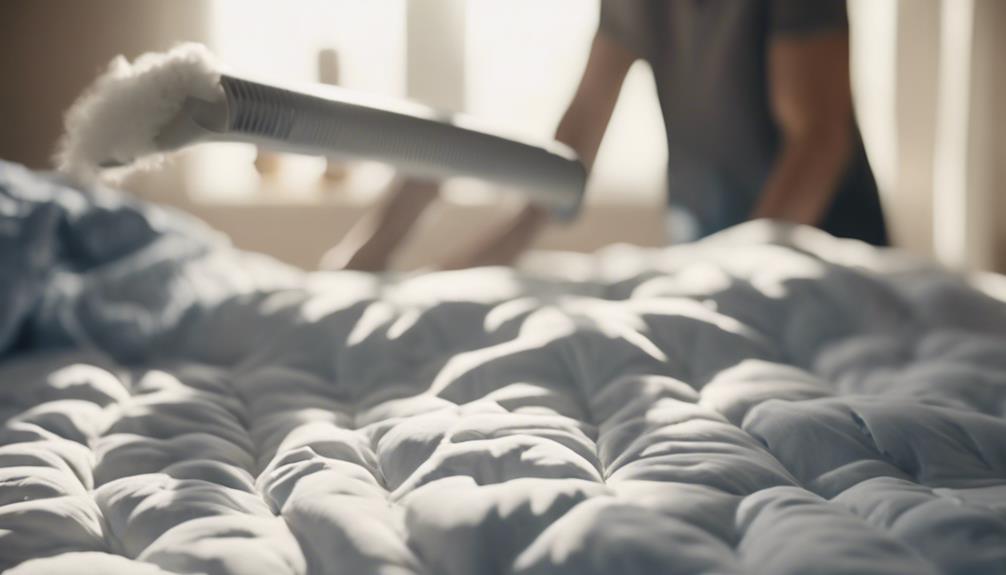
Regularly spot cleaning stains on your white goose down comforter mattress topper is vital to prevent them from setting and maintain its pristine condition. Using a feather bed protector can shield your down comforter from spills, dust, and allergens, extending its lifespan.
Remember to rotate your down comforter mattress topper periodically to guarantee even wear and prevent flat spots. Additionally, air out your down comforter mattress topper regularly to maintain freshness and fluffiness. Consider adding a duvet cover for added protection and easy cleaning.
Enhancing Comfort With a Down Comforter

Enhancing comfort with a down comforter as a mattress topper elevates the overall sleeping experience by providing an added layer of luxury and softness. White duck down, known for its exceptional insulating properties, creates a feather bed effect that's soft yet supportive.
When used as a mattress topper, a down comforter enhances the coziness of your bed, offering an inviting retreat at the end of a long day. The lightweight nature of down comforters makes them easy to manage on your mattress, ensuring a hassle-free experience.
Additionally, many down comforters are OEKO-TEX® certified, guaranteeing that they're free from harmful substances. This certification provides peace of mind regarding the quality and safety of the product you're using.
Frequently Asked Questions
Is Down Good for a Mattress Topper?
Down is excellent for a mattress topper due to its insulation and lightweight, fluffy nature. It offers a plush cushioning layer, enhancing your sleep experience with a luxurious feel.
Down's breathability helps regulate temperature for a comfortable rest. Overall, down is a cozy and comfortable choice that can elevate your mattress comfort level.
What Can I Use Instead of a Mattress Topper?
Instead of a mattress topper, we can explore alternatives like mattress pads, memory foam toppers, or even mattress protectors for added comfort. These options cater to various needs, such as extra cushioning, temperature regulation, or protection against allergens.
When choosing the best option to enhance our sleep quality and overall well-being, we must take into account our individual preferences and requirements.
Can I Use a Feather Duvet as a Mattress Topper?
Yes, a feather duvet can be used as a mattress topper. While it may not offer as much support as a traditional mattress topper, it can provide additional softness and comfort to your bed.
Feather duvets are known for their fluffiness and insulation properties, making your sleep experience cozier. Keep in mind that this makeshift solution may be temporary.
Using a feather duvet as a mattress topper can enhance your overall sleeping experience.
Is a Down Alternative Mattress Topper Hot?
Down alternative mattress toppers, like traditional down, regulate temperature well, making them a cooler option. They're designed with synthetic materials for breathability and cooling properties.
These toppers are typically hypoallergenic and suitable for allergy-prone individuals. Providing a balance of softness, support, and temperature control, they're an excellent choice for those seeking a comfortable night's sleep.
Is It Safe to Use Oxiclean on a Down Comforter That Can Also Be Used as a Mattress Topper?
Yes, it is safe to consider using Oxiclean on comforter or mattress topper made of down material. Oxiclean is a gentle yet effective cleaner that can remove stains and odors without damaging delicate fabrics like down. Just follow the label instructions and spot test first to ensure compatibility.
Conclusion
To sum up, utilizing a down comforter as a mattress topper can offer additional comfort and warmth to enhance your sleep experience.
Were you aware that research has indicated that sleeping with a down comforter can aid in improving the quality of sleep by regulating body temperature?
Therefore, if you're seeking a snug and indulgent solution to upgrade your mattress, consider utilizing a down comforter as a mattress topper for a more restful night's sleep.
Mason – Your Product Expert Mason is your go-to product expert, carefully selecting each item in our collection to ensure it meets your comfort, functionality, and style needs. With his attention to detail and commitment to quality, he ensures that every product we offer enhances your home experience.
Comforter
Can Comforters Get Bed Bugs
Fend off potential bed bug infestations by learning how comforters can harbor these pests, leading to effective prevention strategies.

Yes, comforters can contain bed bugs in their fabric, seams, and folds. These small insects survive on human blood and are most effectively eradicated by using high heat treatment in the dryer. Temperatures exceeding 120°F for 30 minutes kill bed bug eggs, nymphs, and adults efficiently. It is vital to regularly check for indicators like bloodstains and eggshells. Washing in hot water and drying at high heat can aid in getting rid of bed bugs. Keeping clean comforters sealed in plastic bags can prevent re-infestation. To ensure a bed bug-free space, consider investing in protective encasements made of bed bug-resistant materials. Protect yourself from infestations successfully.
Key Takeaways
- Bed bugs infest comforters in seams, folds, and fabric.
- Washing in hot water and high heat drying kills bed bugs.
- Sealing clean comforters in plastic bags prevents re-infestation.
- Regularly inspect for signs like bloodstains and small insects.
- Use protective encasements to create a bed bug barrier.
Understanding Bed Bugs in Comforters

When it comes to understanding bed bugs in comforters, it's crucial to recognize that these pests can easily infest and hide within the fabric, seams, and folds of the bedding. Bed bugs are tiny insects that feed on human blood and are skilled at finding cozy spots to nest, making comforters an ideal environment for them to lay eggs and thrive.
To combat bed bugs in comforters, utilizing high heat treatment in the dryer is a highly effective method to kill bed bug eggs, nymphs, and adults. By subjecting the comforter to temperatures above 120°F for at least 30 minutes, you can guarantee that the entire infestation is eradicated. High heat is a natural and chemical-free approach that's safe for most comforter materials.
It's important to remember that sealing clean comforters in durable plastic bags can also provide protection against bed bug infestations, preventing these pests from infiltrating your bedding and causing further issues.
Signs of Bed Bug Infestation

To detect a bed bug infestation in your comforter, carefully inspect for small, flat insects, droppings, bloodstains, red or brown stains, ivory-colored eggshells, live bed bugs, or dark brown fecal spots.
Look closely at the seams and folds of the comforter where bed bugs like to hide. If you notice tiny insects resembling apple seeds, dark spots or smears that could be bed bug feces, or red and brown stains that might be blood from crushed bugs, these could all be signs of a bed bug infestation.
Additionally, ivory-colored eggshells or live bed bugs near areas where you sleep are strong indicators of a problem. Pay attention to any itchy red skin or bite marks you might've after using the comforter, as these could also signal the presence of bed bugs.
Regularly checking for these signs can help you catch a bed bug infestation early and take appropriate action to address the issue promptly.
Prevention Tips for Comforters
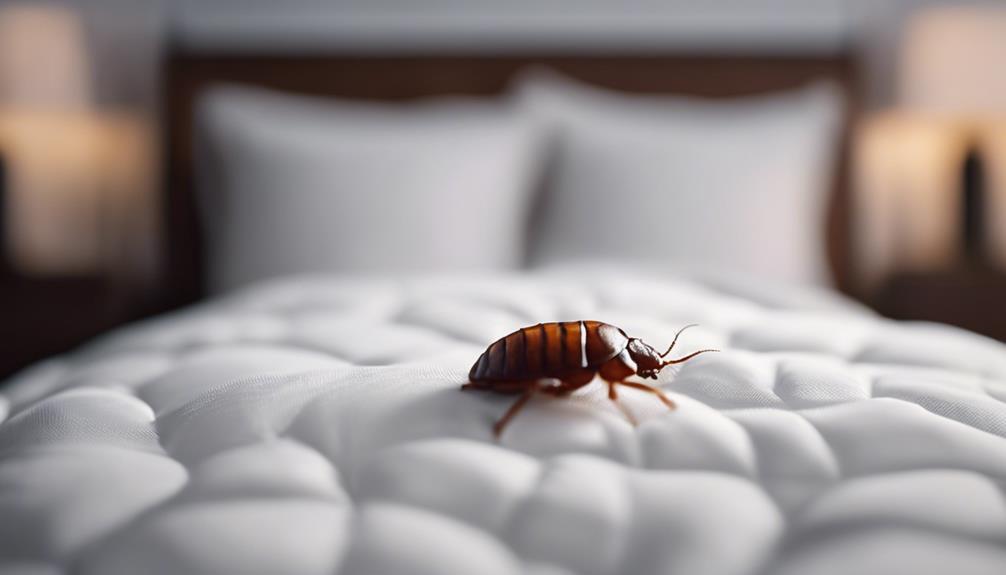
Wondering how to keep your comforter free from bed bugs? To prevent a bed bug infestation in your comforter, there are several proactive steps you can take.
First, regularly inspect your comforter for any signs of bed bugs, such as small reddish-brown stains or tiny dark spots that could indicate their presence. Washing your comforter in hot water and drying it on high heat can help eliminate any potential bed bugs and their eggs. Additionally, sealing your clean comforter in a plastic bag after washing can help reduce the risk of re-infestation.
It's also essential to keep your sleeping area clean and clutter-free, as bed bugs thrive in messy environments. By regularly cleaning your bedding, vacuuming your mattress and bed frame, and minimizing hiding spots for bed bugs, you can significantly lower the likelihood of an infestation in your comforter.
Washing and Treating Infested Comforters

If comforters become infested with bed bugs, the most effective way to eliminate them is by washing the comforter in hot water and drying it on high heat. Heat is bed bugs' worst enemy, as it kills them at all stages of life – eggs, nymphs, and adults. Here is a simple guide to help you effectively wash and treat an infested comforter:
| Steps to Wash and Treat Infested Comforters |
|---|
| 1. Wash the comforter in hot water |
| 2. Dry the comforter on high heat |
| 3. Seal the clean comforter in a durable plastic bag to prevent re-infestation |
When dealing with bed bugs, it's important to remember that washing and drying alone may not be enough. Make sure to also inspect your bed bug mattress and surrounding areas for any signs of infestation. If the problem persists, seeking professional help is the best course of action to ensure thorough removal and treatment.
Using Protective Encasements for Comforters

When seeking additional protection against bed bug infestations in comforters, consider using protective encasements made of durable, bed bug-proof materials. These encasements act as a barrier that makes it difficult for bed bugs to penetrate and hide in the comforter, providing a proactive approach to preventing infestations.
Typically crafted from sturdy, bed bug-proof fabrics, these encasements offer a reliable shield for your comforter. By investing in encasements for your comforters, you can enjoy peace of mind knowing that your bedding is safeguarded against potential bed bug problems.
Remember to regularly inspect and clean encased comforters to maintain a bed bug-free environment effectively. This simple step can greatly contribute to the longevity of your comforter and ensure a hygienic sleeping space.
Frequently Asked Questions
How Can I Tell if My Bedding Has Bed Bugs?
To determine if your bedding has bed bugs, look for brown or red stains, which are droppings and blood respectively. Check for small, flat insects or shed skins. A musty odor and red, itchy bites may also indicate their presence.
If you suspect bed bugs, consider professional inspection and treatment. DIY methods may not completely eliminate the infestation. It's vital to act promptly to prevent further spread and discomfort.
Should I Throw Away My Pillows if I Have Bed Bugs?
If bed bugs infest your pillows, addressing the issue promptly is crucial. Inspect for signs like dark spots, eggs, or live bugs.
Consider professional pest control for effective treatment. Throwing away pillows may not be necessary; proper treatment and encasement can prevent spread and reinfestation.
Act swiftly to control the situation and protect against further bed bug problems.
How Do I Protect My Bed Bugs From My Bedding?
To safeguard bedding from bed bugs, we recommend a proactive approach. Start by regularly washing and drying your bedding on high heat to kill any potential bugs or eggs.
Additionally, seal clean bedding in durable plastic bags to prevent reinfestation. Avoid using insecticide sprays, as they may not be effective and could harm the fabric.
Taking these preventive steps can help protect your bedding from bed bugs and guarantee a restful night's sleep.
How Do You Get Bed Bugs Out of Blankets?
To get bed bugs out of blankets, we recommend placing the blanket in the dryer on high heat. This will effectively kill eggs, nymphs, and adult bed bugs.
After treatment, seal the clean blanket in a durable plastic bag to prevent reinfestation.
Avoid using insecticide sprays as they can be ineffective and leave stains and odors.
For challenging infestations, seek professional pest control help for thorough removal.
Are Comforters a Common Hiding Place for Bed Bugs?
Yes, comforters are a common hiding place for bed bugs. These pesky insects can easily burrow into the folds and seams of the fabric, making it difficult to spot them. Combating bed bug infestations requires thorough cleaning and regular inspections of bedding and furniture.
Conclusion
To sum up, comforters can indeed attract bed bugs if not properly cared for. Just like a cozy blanket that keeps us warm, comforters can unknowingly harbor these pesky pests.
By being vigilant for signs of infestation, practicing prevention techniques, and washing and treating infested comforters promptly, we can guarantee a bed bug-free sleep environment.
Remember, just as we take care of ourselves, it's important to also take care of our bedding to keep those bed bugs at bay.
Comforter
What Size Duvet Cover for Queen Down Comforter
Looking for the perfect duvet cover for your queen down comforter? Let's explore how the right size can transform your bedding experience.

For a queen down comforter, choose a queen-sized duvet cover measuring 90 inches by 96 inches. This size guarantees a snug and seamless fit, allowing the comforter to drape nicely over the edges of the bed. Opting for the correct size prevents shifting and maintains a neat appearance. Corner ties secure the comforter in place for better sleep. If you want to enhance comforter loft and prevent bunching, matching cover and comforter sizes is essential. Discover how different duvet cover sizes cater to various comforter sizes and styles.
Key Takeaways
- Choose a queen-sized duvet cover measuring 90×96 inches for a snug fit.
- Prevent shifting with corner ties in the cover for better sleep.
- Optimal cover fit ensures a neat appearance and proper coverage.
- Enhance comforter loft with a snugly fitting duvet cover.
- European Queen size covers from Plumeria Bay cater to queen down comforters.
Matching Duvet Cover Size
When selecting a duvet cover for a queen down comforter, make sure to choose a queen-sized duvet measuring 90 inches x 96 inches. Matching the size is important to guarantee proper fit and coverage for your queen down comforter.
Using a duvet cover that's too small may result in inadequate coverage, leaving parts of the comforter exposed. By opting for a queen-sized duvet cover, you secure a seamless and snug fit for your comforter. This size provides the ideal dimensions to accommodate your queen down comforter comfortably, allowing it to drape nicely over the edges of the bed.
Additionally, a queen-sized duvet cover enhances the overall aesthetic of your bedding, giving it a neat and polished look. Therefore, always prioritize selecting the correct size when choosing a duvet cover for your queen down comforter to ensure both functionality and style.
Importance of Cover Fit

Ensuring the duvet cover fits snugly over the queen down comforter is vital for maintaining a tidy and comfortable bedding arrangement. Here are some key points to keep in mind:
- Properly fitting covers prevent shifting, ensuring a neat appearance.
- Choosing a queen size cover, typically 90×96 inches, matches the dimensions of the comforter.
- Opting for a cover slightly smaller than the comforter can enhance loftiness and snugness.
- Corner ties in the duvet cover help secure the comforter in place, preventing discomfort during sleep.
- Matching the size of the duvet cover to the queen down comforter is essential for a well-coordinated and visually appealing bedding ensemble.
Enhancing Comforter Loft

To maximize the loftiness of your queen down comforter, selecting a duvet cover that fits snugly and complements its dimensions is crucial. Choosing a queen size duvet cover that matches the size of your comforter guarantees a perfect fit, enhancing both comfort and aesthetic appeal in your bedroom.
Consider opting for a slightly smaller duvet cover for a snug fit, which can boost the comforter's loftiness. Look for duvet covers with corner ties as they help secure the comforter in place and prevent shifting inside the cover.
Additionally, German size and super size duvet covers are available to accommodate different comforter sizes, providing options to suit your specific needs. By properly fitting your down comforter with the right size duvet cover, you can elevate both the comfort level and the visual appeal of your bedding ensemble.
Preventing Shifting Inside Cover

In securing a down comforter within a duvet cover, corner ties play an important role in preventing shifting and maintaining a neat appearance. Corner ties help keep the comforter in place, making sure it doesn't bunch up or move around inside the cover.
To prevent shifting, it's vital to choose a duvet cover that fits the queen down comforter properly. Opt for a snug fit by selecting a cover that matches the dimensions of the comforter. This way, the comforter stays in place, providing a comfortable and consistent sleeping experience.
- Corner ties: Essential for preventing shifting inside the cover.
- Proper fit: Choose a duvet cover that matches the queen down comforter size.
- Neat appearance: Ensures the comforter stays in place for a tidy look.
- Preventing bunching: Corner ties help maintain even coverage.
- Comfortable sleep: A snug fit enhances comfort and prevents discomfort caused by shifting.
Plumeria Bay Options

For a perfect fit with your queen down comforter, consider the European Queen size duvet covers available from Plumeria Bay. These duvet covers are specifically designed to accommodate queen down comforters, ensuring a snug and tailored fit. The dimensions of the European Queen size duvet cover, measuring 95 x 87 inches, make it ideal for your queen down comforter. What's great is that these covers are customizable, allowing you to personalize your bedding while ensuring it stays in place and looks neat.
Plumeria Bay offers discounted prices on their European Queen size duvet covers, making it a cost-effective choice for enhancing both the comfort and style of your bedroom. By opting for a European Queen size duvet cover from Plumeria Bay, you can rest assured that your queen down comforter will be well-protected and beautifully complemented.
Easy Fitting for Comfort and Style

With a queen-sized down comforter typically measuring 90 inches by 94 inches, selecting a duvet cover that measures 90 inches by 96 inches guarantees a perfect fit for both comfort and style. Here are some key points to keep in mind for easy fitting and a plush look:
- Opt for a slightly larger duvet cover to achieve a luxurious and comfortable appearance.
- Make sure the duvet cover has corner ties to keep the queen-sized comforter securely in place.
- Matching the sizes of the duvet cover and comforter will result in a seamless and stylish fit.
- A queen-sized duvet cover measuring 90 inches by 96 inches is the ideal choice for a perfect fit.
- By following these tips, you can effortlessly enhance the comfort and style of your bedding with the right duvet cover for your queen size down comforter.
Frequently Asked Questions
What Size Duvet Cover for Queen Comforter?
When choosing a duvet cover for a queen comforter, opt for one that matches the queen size dimensions, typically 90 inches by 96 inches. Make sure it's large enough to fit the comforter properly.
Consider an oversized cover for a luxurious look. Look for corner ties to keep the comforter in place. Check dimensions of both comforter and cover for compatibility.
Compatibility guarantees a snug and comfortable fit.
What Size Duvet Cover for Down Comforter?
When selecting a duvet cover for a down comforter, it's important to match the dimensions for a proper fit. Look for a queen size duvet cover that corresponds to the size of the comforter, usually around 90 by 94 inches.
Opt for one with corner ties to secure the comforter in place. Choose a cover slightly larger than the comforter for a snug fit. Verify the exact measurements to avoid any fitting issues.
Should Your Duvet Cover Be the Same Size as Your Duvet?
We always recommend choosing a duvet cover that matches the size of your duvet for the best fit and comfort. Having a duvet cover that's the same size as your duvet guarantees that it will stay in place and provide even coverage. This compatibility prevents shifting and guarantees a snug fit.
Should I Put My Down Comforter in a Duvet Cover?
We always recommend putting your down comforter in a duvet cover. It helps protect the comforter from dirt, stains, and wear, and makes cleaning easier since you can simply remove and wash the cover.
Plus, a duvet cover can enhance the appearance of your bedding and add a decorative touch to your bedroom. Opting for a duvet cover is a smart choice that adds style, comfort, and longevity to your bedding.
What Size Duvet Cover Do I Need for a Full Bed with a Queen Comforter?
When choosing a duvet cover for a full bed with a queen comforter, it’s best to opt for a cover designed for a queen comforter. This will ensure a proper fit and prevent any bunching or discomfort. A queen-sized duvet cover will provide ample coverage and a snug fit for your queen comforter on a full-sized bed.
Conclusion
When choosing a duvet cover for your queen down comforter, it's important to select the right size to enhance comfort and prevent shifting.
For example, a queen-sized duvet cover from Plumeria Bay offers a perfect fit for your comforter, ensuring both style and functionality.
By choosing the right size, you can enjoy a cozy and stylish bedroom setup that will keep you comfortable all night long.
Mason – Your Product Expert Mason is your go-to product expert, carefully selecting each item in our collection to ensure it meets your comfort, functionality, and style needs. With his attention to detail and commitment to quality, he ensures that every product we offer enhances your home experience.
-

 Vetted6 months ago
Vetted6 months ago14 Best Personalized Father's Day Gifts for Your Husband – Show Him You Care
-

 Vetted7 months ago
Vetted7 months ago15 Best EMS Foot Massagers for Neuropathy to Soothe Your Feet
-

 Alfresco6 months ago
Alfresco6 months agoAlfresco Stacker Doors: Seamless Indoor-Outdoor Living!
-

 Tableware and Dining Accessories7 months ago
Tableware and Dining Accessories7 months agoWhat Is the Meaning of the Word Tableware
-

 Tableware and Dining Accessories7 months ago
Tableware and Dining Accessories7 months agoWhen Is Tableware on Sale at Hobby Lobby
-

 Tableware and Dining Accessories7 months ago
Tableware and Dining Accessories7 months agoWhich of the Following Is Not Classified as Tableware
-

 Craft and Textiles7 months ago
Craft and Textiles7 months ago15 Best Places to Buy Appliances for Your Home – Top Retailers Reviewed
-

 Vetted6 months ago
Vetted6 months agoBattle Born Batteries Review: Reliable Power Solution














